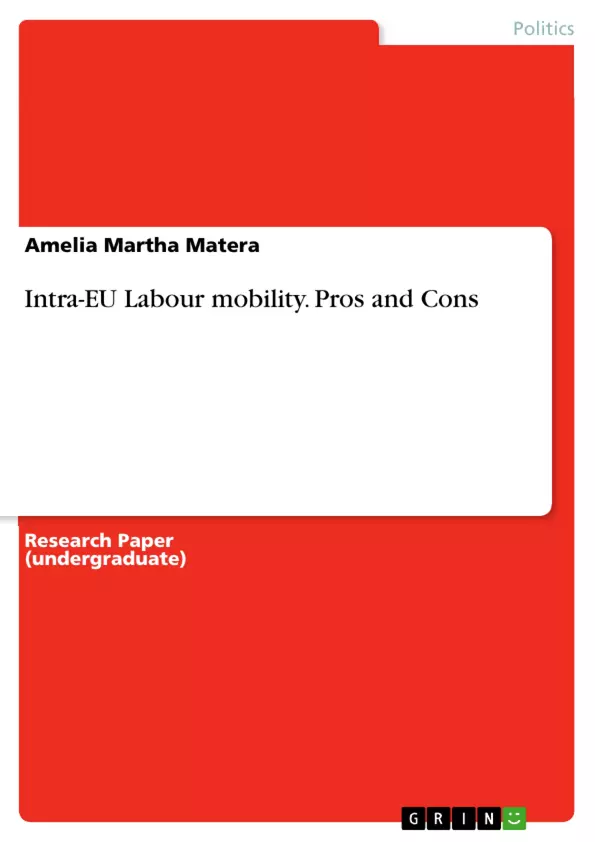Intra-EU migration is one of the four fundamental freedoms of the EU, together with free movement of goods, services and capital, introduced with the Rome Treaties in 1957. The first part of this paper is dedicated to elucidate labour mobility and its characteristic, the central discussion and aim is to analyse the pro and contra of labour mobility within the European Union, and in the concluding part, I will mention some proposals made by scholars, which could support positive changes in the field of intra-EU mobility. Although the literature about labour mobility is quite exhaustive, the main problem are the resources. Analysing intra-EU migration at macro level is quite different, there is a lack of data and transnational surveys. Although a detailed analysis is not provided, scholars try to comprehend more about the phenomena. This topic has a strong meaning in our lives, at several levels. The author Baldwin explains that migration has a political and economic meaning within the EU. From a political perspective citizens of EU enjoy mobility and this affects the image European citizens have about their neighbours; from an economical point of view, which is the focus of this paper, mobility of labours allows worker to best use their skills and experiences, and firms can enjoy from competent workers. Baldwin`s analysis begins by defining the difference between goods and national labour markets, which have their own regulation. According to Baldwin the reason for this is that Member States have limited migration within the EU and there are important differences among the MS, different legislations and different practices. Within the EU we find countries more privileged than others. What makes individuals take the decision to move? Zimmermann analyses the main push-factors, which make EU citizens move to other MS, these factors are: job, education, family and others. At the same time, the author suggests that future factors could be: work and income, social network, housing and local environment.
Inhaltsverzeichnis (Table of Contents)
- Introduction
- Labour mobility in the EU
- Cons of intra-EU labour mobility
- Social Dumping
- Integration
- Pros of the intra-EU labour mobility
- Obstacles
- Proposals for the future and conclusion
Zielsetzung und Themenschwerpunkte (Objectives and Key Themes)
This paper aims to analyze the pros and cons of intra-EU labor mobility. It explores the characteristics of labor mobility within the European Union, examining both the positive and negative effects of this freedom of movement. The paper also considers obstacles to labor mobility and proposes solutions for the future.
- The impact of labor mobility on the European economy
- The role of social policies in shaping labor mobility patterns
- The challenges of integration and multiculturalism in the context of labor mobility
- The relationship between labor mobility and unemployment
- The influence of public opinion on policies related to labor mobility
Zusammenfassung der Kapitel (Chapter Summaries)
- Introduction: This chapter introduces the concept of intra-EU labor mobility as one of the four fundamental freedoms of the EU and sets out the objectives and structure of the paper.
- Labour mobility in the EU: This chapter explores the characteristics of labor mobility within the EU, discussing its economic and political significance. It analyzes the factors that drive individuals to migrate within the EU and highlights the diverse routes and effects of intra-EU migration.
- Cons of intra-EU labour mobility: This chapter examines the potential negative effects of intra-EU labor mobility, focusing on issues like social dumping, integration challenges, and the influence of public opinion. It considers arguments suggesting that labor mobility can exacerbate economic disparities and lead to social tensions.
- Pros of the intra-EU labour mobility: This chapter presents the potential positive effects of intra-EU labor mobility, highlighting its contribution to economic efficiency, growth, and productivity. It emphasizes the liberal perspective on labor mobility, arguing that it can help match labor supply with demand and reduce unemployment.
Schlüsselwörter (Keywords)
This paper focuses on the key concepts of intra-EU labor mobility, economic integration, social dumping, integration challenges, public opinion, unemployment, and the impact of free movement on the European economy. It explores the complex interplay between these concepts and their implications for policymaking.
- Quote paper
- B.A. Integrated European Studies Amelia Martha Matera (Author), 2018, Intra-EU Labour mobility. Pros and Cons, Munich, GRIN Verlag, https://www.grin.com/document/442598



